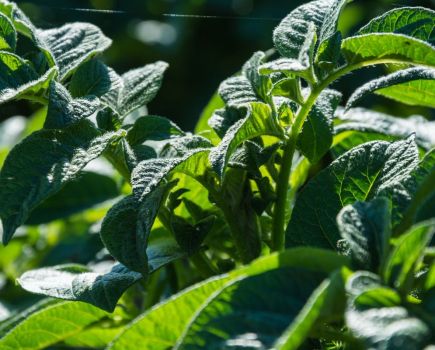Since blight became an even more aggressive disease, it’s become the norm to start blight programmes early and keep spray intervals tight. CPM gathers some views on where best to target blight products during the crop’s growth.
36_A2 is a different beast.
By Lucy de la Pasture and Rob Jones
In many ways it seems as though little has changed in the seasonal battle with late blight (Phytophthora infestans). While that may not actually be the case, where growers follow the advice of adhering to intervals and maintaining application rates they’re unlikely to come unstuck, says Nick Winmill, Agrii national potato specialist.
Regular fungicide applications alone will not be enough to protect crops, spraying the right product at the right time is as important, he adds. “The mantra is to start early, maintain intervals and keep disease out from the start. This approach hasn’t changed in 30 years, but problems arise when the first spray is delayed, or intervals extend beyond the seven days that most products can be expected to protect crops for, under typical conditions,” says Nick.
That’s when getting product selection right is even more crucial. “Cymoxanil is a valuable curative and a good mixer as well as being in many pre-formulated options. Profilux (cymoxanil+ mancozeb) gives a full complement of mancozeb from a protection perspective and useful amount of cymoxanil to act as a curative.
“Another strong product at this stage is Lieto (cymoxanil+ zoxamide). Zoxamide has some anti-sporulant activity though it’s not as effective as fluopicolide, amisulbrom or cyazofamid-containing products in controlling tuber blight.
“Importantly, zoxamide stops spores developing into sporangia before they’re released. This raises the importance of timing as the product only acts before the zoospores are motile,” he explains.
The importance of timing is endorsed by Simon Alexander, independent agronomist covering north Norfolk. “Risk is a relative statement and it should be remembered that the situation one day can be significantly different the next.
“For this reason, I prefer seven-day intervals underpinned by a combination of two robust actives. There’s scope to bolster this approach when pressure increases, but only if crops are protected well in advance. Programmes that rely on chasing disease once it’s entered the crop are bound to fail,” he adds.
As the crop moves into rapid canopy then systemic activity becomes important since protectant and curative activity doesn’t protect any new growth.
“My preferred systemic is propamocarb or oxathiapiprolin (Zorvec Enicade) with appropriate partners, bearing in mind the total number of oxathiapiprolin applications is limited to four per season,” says Nick.
Balancing the use of oxathiapiprolin as the crop nears tuber initiation presents challenges. “As the season moves on, I may continue using Zorvec but, to avoid block applications of oxathiapiprolin, I will advise the use of good curative actives to protect the performance of oxathiapiprolin for as long as is possible,” he notes.
Ensuring crops are protected from the start is not a new approach, but there are other developments that will shape how growers and their advisers approach blight strategies during this season.
For Nick the continued spread of the 36_A2 strain, which has shown itself to be more aggressive than any previous new blight strains, is a serious concern. Simon highlights the increased range of local sources of blight inoculum, which he finds worrying.
“Local sources of infection are likely to be a problem this season. The mild winter, combined with a high carryover of unharvested potatoes from the end of last season, means there are likely to be a greater number of volunteers than typical. It’ll be essential to keep on top of these from the start to minimise the sources of infection,” says Simon.
Nick outlines his approach to new aggressive strains. “36_A2 is a different beast and, while there’s no need to panic, you do need to think about intervals and whether the products being applied are robust enough to protect crops. We don’t at this stage fully understand how reliable variety resistance is to these more aggressive blight genotypes and how this may affect our approach to IPM.”
All of these factors have to be considered within the constraints of a responsible resistance management programme. For this reason, Nick is grateful that mancozeb hasn’t yet been withdrawn.
“Losing mancozeb would be a game-changer. It’s the mainstay of programmes against early blight (Alternaria solani) and, as a multisite, a valued mixer in a programme against late blight.”
Although scheduled for review last year, there’s a suggestion mancozeb will continue to be available, at least in the short term, not least because the restrictions implemented in response to the coronavirus pandemic mean that discussions on its future have had to be deferred, he adds.
With much to consider, Nick believes it’s easier to work through the options at critical periods of the season and then fill in the gaps.
“In some respects, it’s easier to work backwards from the end of the season rather than forwards from the start. Gozai (pyraflufen-ethyl) is likely to be the preferred desiccant, but applications will need to be timed carefully if it’s to be applied with a fungicide. Bayer has found the combination of Infinito (propamocarb + fluopicolide) and Spotlight Plus (carfentrazone-ethyl) to be physically compatible, which adds another option,” he says.
Blight tactics in Herefordshire
Frontier agronomist Fergus Hawkins advises on 600ha of potatoes across Herefordshire and is forecasting that this season could be the most challenging ever for the industry, especially when factoring in a global pandemic that nobody saw coming.
“The higher than average rainfall in my area always equates to more high-risk periods for blight, especially if seasonal temperatures are high. Blight control always begins with early planning and doing everything possible to prevent blight from entering the crop from day one,” he says.
“Controlling volunteers in neighbouring cereal crops and in the increased areas of conservation crops that have gone in this spring is a must.”
Since gaining his BASIS qualifications four years ago through Frontier’s graduate training programme, Fergus has already seen and experienced significant change during that short time. Dealing with key product losses such as linuron and diquat, coupled with new, more aggressive blight strains has been a major challenge.
“36_A2 and 37_A2 are game changers for growers, given we know they cycle much faster at lower temperatures and produce higher numbers of sporangia per lesion. In my area there’s also a high risk of seed-borne blight, particularly in earlier potato crops, so the early rosette sprays start at seven-day intervals with water volumes kept at correct levels to maximise coverage of each spray.”
Product choice for these early sprays depends very much on pressure, says Fergus. “Typically I will start with cymoxanil+ mancozeb (Curzate M) or benthiavalicarb+ mancozeb (Valbon). But if blight pressure is high, then it’s Ranman Top (cyazofamid) or fluopicolide+ propamocarb – particularly if the variety has an early tuber set. In a high-pressure situation I’ll also reduce spraying intervals to five days,” he explains.
“Through rapid canopy and into stable growth I recommend oxathiapiprolin for its systemic activity alongside cymoxanil+ mancozeb, while factoring in the weather, the variety and economics. For effective tuber blight control you have to be aware of the variety’s own tuber blight resistance rating and its end market – green top or storage,” he comments.
For late season control, Fergus’s fungicide choice is Ranman Top, so he plans to try and save two to three applications for the end of the season. One of these he’ll reserve to go after flailing, particularly as the flail and spray approach will take longer to completely kill green leaf and stems now diquat is no longer available.
Stef Dierickx, zonal expert in potatoes for Belchim Crop Protection, has studied the rise in outbreaks of both the 36_A2 and 37_A2 strains in the UK as well as Germany, the Netherlands, France and Belgium. Endorsing Fergus’ approach, he highlights the devastating effects of the EU_36 genotype on crops and advises all UK growers to be on their guard during the season ahead.
“Both these newer strains, but particularly 36_A2, cycle so quickly that if they do get into the crop, blight is almost impossible to stop. Even expensive block sprays designed to stop blight in the field will not work in many cases that I’ve seen,” he says.
He advises building programmes around products with curative activity to block any potential infection from latent infected tubers. During the rapid canopy phase he suggests maintaining a very strict programme with short spraying intervals and using products at their full dose rates, while alternating different modes of action. He also suggests inclusion of a curative compound, such as cymoxanil, in all sprays.
For later season tuber control, Stef advocates spraying before any forecast rain, even if it means shortening a spraying interval. This is so the fungicide applied is ready to give protection before leaves get wet.
“For late season control after crop burndown, it’s worth noting that Ranman Top and amisulbrom (Shinkon) share the same mode of action, so I would advise use of Ranman Top and fluopicolide+ propamocarb to help manage any remaining fungicide resistance risk more effectively,” he concludes.




